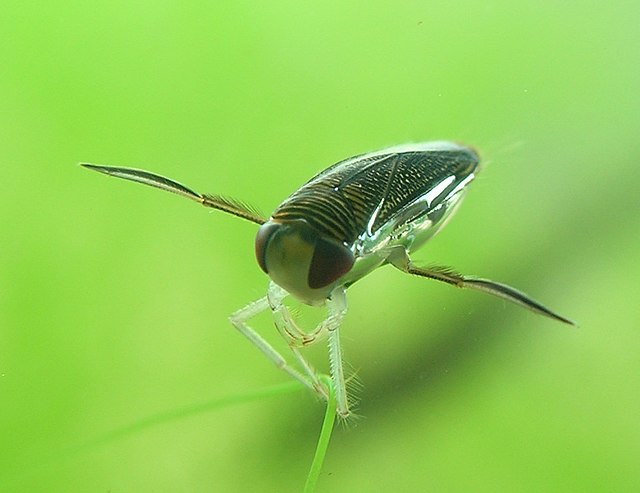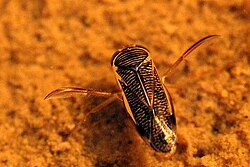Top Qs
Timeline
Chat
Perspective
Corixidae
Family of true bugs From Wikipedia, the free encyclopedia
Remove ads
Corixidae is a family of aquatic insects in the order Hemiptera. They are found worldwide in virtually any freshwater habitat and a few species live in saline water.[1] There are about 500 known species worldwide, in 55 genera, including the genus Sigara.
Members of the Corixidae are commonly known as lesser water boatmen: the term used in the United Kingdom to distinguish species such as Corixa punctata[2] from Notonecta glauca, or greater water-boatman, an insect of a different family, Notonectidae.
Remove ads
Morphology and ecology
Summarize
Perspective
Corixidae generally have a long flattened body ranging from 2.5 to 15 mm (0.1–0.6 in) long.[1] Many have extremely fine dark brown or black striations marking the wings. They tend to have four long rear legs and two short front ones. The forelegs are covered with hairs and shaped like oars, hence the name "water boatman". Their four hindmost legs have scoop- or oar-shaped tarsi to aid swimming.[3] They also have a triangular head with short, triangular mouthparts. Corixidae dwell in slow rivers and ponds, as well as some household pools.

Unlike their relatives the backswimmers (Notonectidae), who swim upside down, Corixidae swim right side up. It is easy to tell the two types of insects apart simply by looking at the swimming position.[1]
Corixidae are unusual among the aquatic Hemiptera in that some species are non-predatory, feeding on aquatic plants and algae instead of insects and other small animals. They use their straw-like mouthparts to inject enzymes into plants. The enzymes digest the plant material, letting the insect suck the liquified food back through its mouthparts and into its digestive tract.[1] However, most species are not strictly herbivorous and can even be completely predatory, like those of the subfamily Cymatiainae.[4] In fact, Corixidae have a broad range of feeding styles: carnivorous, detritivorous, herbivorous and omnivorous.
Some species within this family are preyed upon by a number of amphibians including the rough-skinned newt (Taricha granulosa).[5]
The reproductive cycle of Corixidae is annual. Eggs are typically oviposited (deposited) on submerged plants, sticks, or rocks. In substrate limited waters (waters without many submerged oviposition sites), every bit of available substrate will be covered in eggs.

Remove ads
Genera
Summarize
Perspective
These 52 genera belong to the family Corixidae:
- Acromocoris Bode, 1953 g
- Agraptocorixa Kirkaldy, 1898 g
- Archaecorixa Popov, 1968 g
- Arctocorisa Wallengren, 1894 i c g b
- Bakharia Popov, 1988 g
- Bumbacorixa Popov, 1986 g
- Callicorixa White, 1873 i c g b
- Cenocorixa Hungerford, 1948 i c g b
- Centrocorisa Lundblad, 1928 i c g
- Corisella Lundblad, 1928 i c g b
- Corixa Geoffroy, 1762 i c g
- Corixalia Popov, 1986 g
- Corixonecta Popov, 1986 g
- Corixopsis Hong & Wang, 1990 g
- Cristocorixa Popov, 1986 g
- Cymatia Flor, 1860 i c g b
- Dasycorixa Hungerford, 1948 i c g b
- Diacorixa Popov, 1971 g
- Diapherinus Popov, 1966 g
- Diaprepocoris c g
- Ectemnostegella Lundblad, 1928 g
- Gazimuria Popov, 1971 g
- Glaenocorisa Thomson, 1869 i c g b
- Graptocorixa Hungerford, 1930 i c g b
- Haenbea Popov, 1988 g
- Heliocorisa Lundblad, 1928 g
- Hesperocorixa Kirkaldy, 1908 i c g b
- Liassocorixa Popov, Dolling & Whalley, 1994 g
- Linicorixa Lin, 1980 g
- Lufengnacta Lin, 1977 g
- Mesocorixa Hong & Wang, 1990 g
- Mesosigara Popov, 1971 g
- Morphocorixa Jaczewski, 1931 i c g
- Neocorixa Hungerford, 1925 i c g
- Neosigara Lundblad, 1928 g
- Palmacorixa Abbott, 1912 i c g
- Palmocorixa b
- Paracorixa Stichel, 1955 g
- Parasigara Poisson, 1957 g
- Pseudocorixa Jaczewski, 1931 i c g
- Ramphocorixa Abbott, 1912 i c g b
- Ratiticorixa Lin, 1980 g
- Shelopuga Popov, 1988 g
- Siculicorixa Lin, 1980 g
- Sigara Fabricius, 1775 i c g b
- Sigaretta Popov, 1971 g
- Trichocorixa Kirkaldy, 1908 i c g b
- Velocorixa Popov, 1986 g
- Venacorixa Lin Qibin, 1986 g
- Vulcanicorixa Lin, 1980 g
- Xenocorixa Hungerford, 1947 g
- Yanliaocorixa Hong, 1983 g
Data sources: i = ITIS,[6] c = Catalogue of Life,[7] g = GBIF,[8] b = Bugguide.net[9]
Remove ads
References
External links
Wikiwand - on
Seamless Wikipedia browsing. On steroids.
Remove ads

